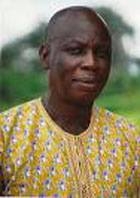Review of History and Political Science, 1(1), pp. 18-25.
Abstract
Nigeria has produced a great variety of art traditions and her size, diverse geography and people have contributed to sculptural richness. Studies on these traditions have been restricted to materials from the ethnographic present and generally lack time depth. The reasons for this is probably the paucity of material from archeological excavations and the fact that some objects, notably made of wood, fiber and mud, cannot survive for long periods because of humidity, termites and other natural or human agencies. This paper which utilized relevant secondary sources of data is aimed at examining the motivation for making art, particularly sculpture in African society until recently. It revealed that the main motives for making sculpture in Africa particularly Nigeria, until recently, was religion, prestige and festivities. However , religion more than anything else provided the primary stimulus for the making of sculpture. The paper however, recommended intensification of archeological excavation in parts of Nigeria to generate new evidence on art traditions especially sculpture.
Full Text: PDF
Akpomuvie. Orhioghene. Benedict (2013). Art, Religion and Symbolic Beliefs in Traditional African Context: A Case for Sculpture. Review of History and Political Science, 1(1), pp. 18-25.
Andah, B. (1988), African Anthropology. Ibadan; Shaneson Limited.
Boas, F. (1927), Primitive Art. Oslo: Aschemhong.
Fagg, W. and List, H. (1990), Nigerian Images. Great Britain; Camelot Press.
Fagg, B. (1990), Nok Terracotta. London; Ethnographica.
Fagg, W. (1982), Yoruba Sculpture of West-Africa. London; John III Pemberton and Bryce Holcome.
Fagg, W. (1958), The Sculpture of Africa. New York; Harker Art Books.
Brain, R. (1980), Art and Society in Africa: Introduction. London.
Adepegba, C.O. (1994), A historical sculpture of West Africa; A catalogue of Exhibition of African Sculpture. Carlisle: Trout Gallery.
Ekpo, E. (1977), Two thousand years Nigeria Art. Lagos: Federal Department of Antiquities. Horton, R. (1965), Kalabari Sculpture. Lagos.
Beier, U. (1957), the Story of Sacred Wood Carvings from one small Yorubal Town. Lagos. Trowel, M. (1964), Classical African Sculpture. London.
Ekpo, E. (1974), Recent Excavations in Ife an and Owo and their implications for Ife and Benin Studies. Unpublished PhD Thesis, University of Ibadan.
Ray, B.C. (1976), African Religions: Symbol, Ritual and Community. New York; Prentice Hall.
Decraemer, W. Vasina, J. and Fox, R.C. (1976), Religious Movements in Central Africa: A Theoretical Study. Comparative Studies in Society and History, 18(4): 455 – 475.
Tylor, E.D. (1871), Primitive Cultures; Researchers into the Development of Mythology, Philosophy, Religion, Art and Custom. 2 Volumes, London: J. Murray
Munro, (1975); Art Classification of the, Encyclopaedia Britannica 2.81.
Benedict, R. (1959), Patterns of Culture. New York; Mentor Book.

Dr. Akpomuvie Benedict is a Senior Lecturer in Sociology Department, Delta State University, Abraka. At the University of Ibadan, Nigeria, he obtained a B.A degree in Anthropology and an M.A and Ph.D degrees in Anthropology from the renowned Institute of African Studies in 1998 and 2009 respectively.
His research interests are: association and development, cultural studies, gender study, rural sociology, African philosophy etc. Akpomuvie Benedict is a Fellow of the Institute of Industrial Administration of Nigeria and currently the co-ordinator of Postgraduate Programmes in the Department of Sociology, Delta State University, Abraka
Browse Journals
Journal Policies
Information
Useful Links
- Call for Papers
- Submit Your Paper
- Publish in Your Native Language
- Subscribe the Journal
- Frequently Asked Questions
- Contact the Executive Editor
- Recommend this Journal to Librarian
- View the Current Issue
- View the Previous Issues
- Recommend this Journal to Friends
- Recommend a Special Issue
- Comment on the Journal
- Publish the Conference Proceedings
Latest Activities
Resources
Visiting Status
| 335 | |
| |
387 |
| |
8508 |
| |
11900 |
| 1335851 | |
| 8 |
 The Brooklyn Research and Publishing Institute
The Brooklyn Research and Publishing Institute